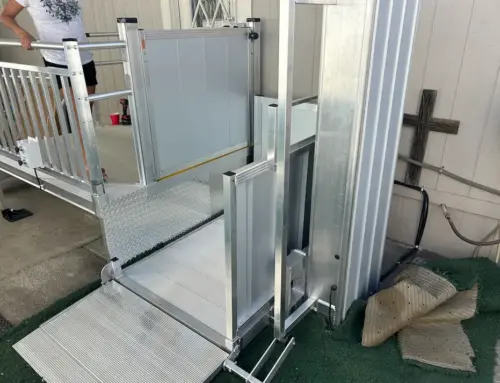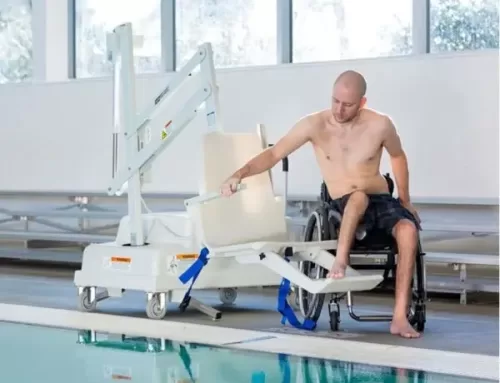The fear of falling is common among older adults and their loved ones. With more than 1.6 million elderly individuals in the US seeking emergency room care for fall-related injuries each year, it’s crucial to address this issue head-on. Overcoming fear of falling in elderly can greatly reduce the risk of future falls. This psychological barrier often stems from previous experiences or concerns about physical limitations as we age. It’s important to understand that this fear can actually increase one’s chances of experiencing a fall.
By taking proactive steps and implementing suitable strategies, seniors who still live at home can regain confidence in their mobility and independence while reducing the risk of falling. Today, we’ll explore five practical tips for breaking the cycle of fear associated with falls among elderly individuals.
Why are Seniors Afraid of Falling?
As we age, our bodies undergo changes that can disrupt our normal balance and coordination. This, coupled with factors like certain medications or cognitive impairments such as dementia, increases the likelihood of falls among seniors. In fact, according to the Centers for Disease Control and Prevention (CDC), in an average year, 1-in-3 seniors experience a fall. These falls result in 2.8 million injuries, 800k hospitalizations, and tragically claim around 27k lives.
It’s unfortunate that many seniors keep their fear of falling hidden from others – even their own adult children. If you suspect your loved one worries about falling, remember, there are reliable ways to restore their peace of mind while reducing the risk of falls.
5 Tips for Overcoming Fear of Falling in Elderly
Let’s face it, the fear of falling can be chilling and paralyzing for our elderly dear ones. The lack of confidence plays a great part in this. Starting with building your confidence, we’ll explore five actionable tips that will help you break free from the cycle of fear and live a more independent life.
1. Realize the Importance of Confidence
Understanding the importance of confidence is key to overcoming fear of falling in elderly. For older adults, building strength and improving balance can greatly boost their self-assurance. There are specialized exercise classes and programs designed specifically to enhance balance and increase overall strength among seniors with mobility concerns.
These classes often include personalized assessments that help individuals understand their individuality. At the same time, the classes demonstrate how exercises can effectively reduce those risks.
Local Area Agencies on Aging are an excellent resource for finding these classes in your area. Additionally, there are video or DVD programs available for seniors who may be unable to attend in-person sessions.
2. Create a Secure Home Environment to Overcome Fear of Falling Elderly
It’s important that you make adjustments and incorporate different safety measures to create a secure home environment. By making simple modifications and adding safety features, such as grab bars, handrails, and bath safety products, we can significantly reduce fall risks within our own homes.
-
Install Grab Bars

Installing grab bars in key areas of your home can provide crucial support and stability, helping to prevent falls. There are various types of grab bars available, such as L-shaped bars that offer a firm grip when getting on and off the toilet or in and out of the shower.
Another option is the Dependa-Bar, which locks securely into different positions for added convenience. PT rails are versatile grab bars used for additional support while going up and down two or more stairs. Physical therapists often use it during gait training. These sturdy fixtures give you something solid to hold onto while moving around, increasing confidence and reducing fall risk.
-
Add Automatic Door Openers
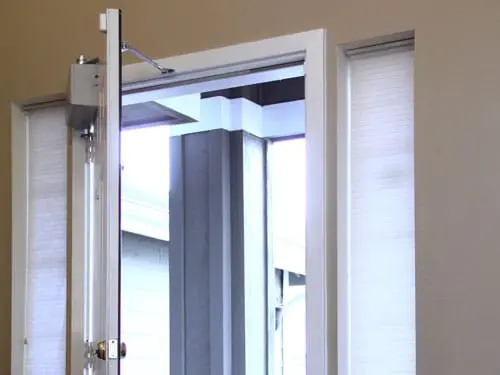
Adding automatic door openers to your home can be a game-changer when it comes to overcoming fear of falling in elderly. With just a push of a button, these devices assist in opening and closing doors effortlessly, making entry and exit smooth and safe.
They can also hold the door open while you pass through, providing added convenience. It’s an excellent solution for those with limited mobility or strength who struggle with traditional door knobs or handles. Automatic door openers also promote independence by eliminating physical strain or potential accidents associated with manually operating doors.
-
Remove Throw Rugs
While throw rugs may add style and warmth to the decor, they can also become trip hazards. Negotiating with seniors who have an emotional attachment to their rugs may be challenging. But emphasizing the importance of safety can help them understand.
If removing the rug isn’t an option, consider finding one that is heavy enough to stay in place or has a rubber backing that reduces slipping risks. Additionally, using two-sided tape to secure the edges of the rug can minimize tripping hazards effectively.
-
Install Handrails on Stairs and Steps
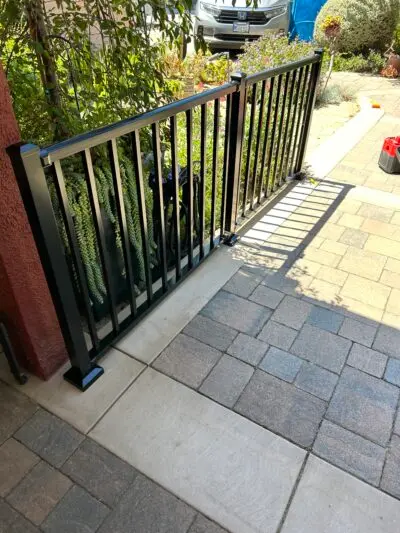
One of the key areas where falls can occur is on stairs and steps. Installing handrails along staircases provides stability and support, reducing the risk of slipping or losing balance.
Handrails offer a steady grip when ascending or descending, giving seniors that extra level of confidence to move around their homes safely. Don’t overlook this simple yet effective modification to prevent falls and promote independence in daily activities.
-
Wear Safe Shoes and Clothing
Proper footwear and clothing choices play a crucial role in reducing the risk of falls. Ill-fitting shoes or loose clothing can contribute to instability and increase the chances of tripping or getting caught on furniture.
When selecting shoes for seniors, it’s important to avoid high heels, mules, sandals without back closures, and poorly fitting footwear. Rubber-soled shoes are recommended for outdoor activities but may not be suitable if someone tends to shuffle while walking.
As for clothing, weight fluctuations can affect how well garments fit. Pants that hang around the ankles or have wide legs pose potential tripping hazards. Long skirts and baggy tops with pockets also carry the risk of catching on objects.
By ensuring proper shoe fit and choosing appropriate attire, we can significantly reduce fall-related concerns among elderly individuals.
-
Install Bath Safety Products
Installing bath safety products is essential for reducing the risk of falls in the bathroom. Consider adding items like grab bars next to toilets and in bathing areas, non-slip coatings on shower floors, and raised toilet seats with handrails for added stability. These modifications can provide a sense of security and make daily activities safer for older adults.
Remember, it’s crucial to consult professional installers or occupational therapists who specialize in home safety adaptations to ensure proper placement and functionality.
-
Install Stair Lifts
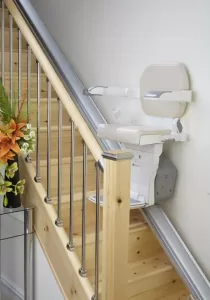
For individuals who have difficulty navigating stairs, installing stair lifts can do the trick. These devices provide a safe and convenient way to move between different levels of the home without the fear of falling or exerting excessive physical effort.
Stair lifts come in various models and designs to suit different needs, ensuring that everyone can enjoy increased mobility and independence at home.
3. Eliminate Fall Hazards
One effective way of overcoming fear of falling in elderly is by eliminating potential fall hazards in and around the home. For fall prevention, start by removing any trip hazards, such as slippery throw rugs or cluttered furniture, that may obstruct their path. Ensure adequate lighting on stairs and steps to minimize missteps, and consider installing bath safety tools for added support in the bathroom.
To avoid unnecessary risks, encourage them to stay off step stools or ladders whenever possible. A great preventative measure is to arrange household items they frequently use within arm’s reach.
According to studies conducted by The National Institutes of Health (NIH), addressing fall hazards in our homes has shown remarkable effectiveness in preventing falls among seniors.
4. Encourage Exercise
Regular exercise plays a crucial role in overcoming the fear of falling for seniors. Engaging in low-impact exercises like Yoga, Tai Chi, or chair aerobics can help build muscle strength and improve flexibility, coordination, and balance. It’s also worth noting that physical activity can reduce stress levels and contribute to better quality sleep.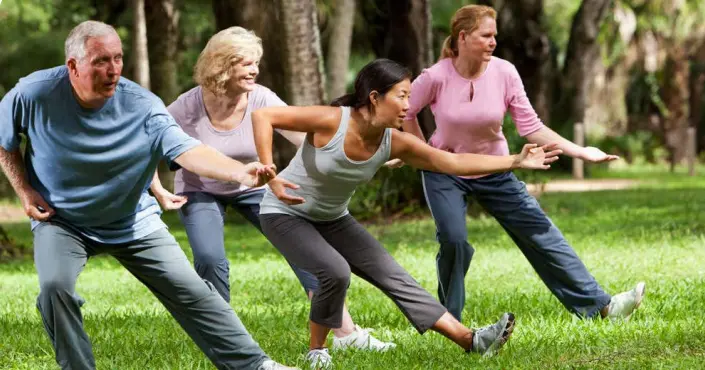
Not only does exercising benefit one’s overall well-being, but it also provides an opportunity to socialize with others. Joining exercise classes allows seniors to meet new friends while staying fit—double – double-win!
Remember, always consult with a healthcare professional before starting any new exercise program tailored specifically to individual needs.
5. Test Their Balance
Consulting with a doctor or physical therapist for a balance assessment can help identify any potential abnormalities and provide reassurance if they perform well.
In cases where balance issues are detected, healthcare professionals may recommend assistive devices. These could be walkers or canes to enhance walking stability and boost self-confidence. These tools not only offer physical support but also serve as visual cues that instill a sense of safety during mobility.
What to Do If a Fall Does Occur
If you or your loved one experiences a fall, it’s important not to panic. There are steps you can take to minimize potential injury and ensure safety even after a fall.
Firstly, the National Institutes of Health suggests spending some time staying still after a fall. Assess any pain and allow blood pressure to stabilize before attempting to get up. Once you feel safe, try crawling towards a stable chair that can support your weight as you pull yourself up from the floor.
Consider investing in a medical alert system with fall detection capabilities. These systems provide peace of mind by ensuring quick access to help if needed during an emergency situation.
While falls may happen despite our best efforts, there are various measures seniors and their families can adopt to reduce the fear of falling and overall risk. By assessing risks carefully and boosting confidence levels through practical strategies like these, elderly individuals have greater opportunities for remaining safely at home, where they belong.
How Can Call Before You Fall Help?
Call Before You Fall is dedicated to promoting safety and independence for seniors facing mobility challenges. With a wide range of mobility safety products, we offer practical solutions that can help reduce the risk of falling and provide peace of mind.
Our expert team understands the unique needs of older adults and can recommend suitable products. Like grab bars, automatic door openers, bath safety products, and more – tailored to individual requirements. By working with Call Before You Fall, you’ll receive personalized assistance in finding the right tools to improve balance, strength, and confidence.
Don’t let the fear of falling limit your lifestyle. Reach out to Call Before You Fall today for more information on how our products can support you in overcoming fear while maintaining an active and independent life!


